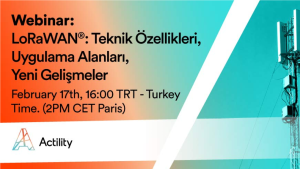LoRaWAN®: Teknik Özellikleri, Uygulama Alanları, Yeni Gelişmeler
LoRaWAN®: Teknik Özellikleri, Uygulama Alanları, Yeni Gelişmeler

- This event has passed.
LoRaWAN®: Teknik Özellikleri, Uygulama Alanları, Yeni Gelişmeler
February 17 @ 16:00 - 17:00 Europe/Istanbul

Join LoRa Alliance member, Actility, for their upcoming webinar: LoRaWAN®: Teknik Özellikleri, Uygulama Alanları, Yeni Gelişmeler on February 17th, 2022 at 16:00 TRT – Turkey Time / 2PM CET Paris. This webinar will be in Turkish.
Join Alper YEGIN, VP of Advanced Technology Development at Actility, and Vice-Chair of BoD, Chair of the Technical Comitee at the LoRa Alliance, to discover all the details in LoRaWAN technology, from its technical features to its latest applications and developments, explained first-hand by a noted expert in the field.
